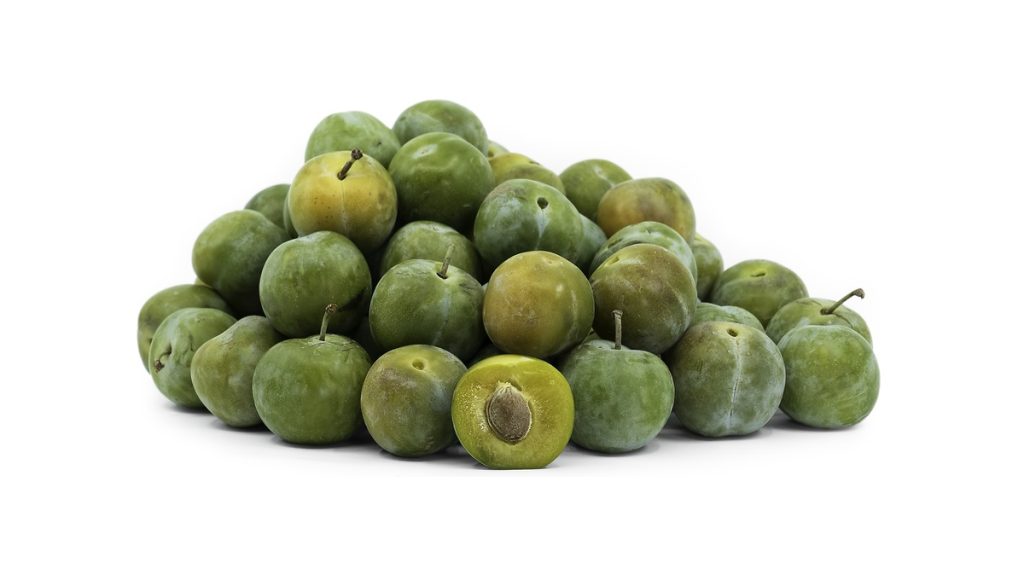Dogs can eat greengages in moderation as they are not toxic to them. It’s essential a dog owner removes the pits before offering this fruit.
Greengages, a variety of sweet plums rich in vitamins and fiber, can provide a healthy snack option for your canine companion if served properly.
These small, green fruits are low in calories but high in antioxidants, which can benefit your dog’s overall health when included as part of a balanced diet.
Despite greengages being generally safe for dogs, keeping portions small is key, as the fruit’s sugar content can lead to obesity or dental issues if consumed excessively.

Health Benefits Of Greengages For Dogs
Greengages are packed with vitamins and fiber that can benefit dogs. They help with digestion and maintain healthy skin.
Vitamin C in greengages boosts the immune system. They also contain antioxidants that fight free radicals. Let’s explore the advantages:
- Vitamin A: Good for vision.
- Vitamin C: Strengthens immunity.
- Dietary Fiber: Aids in digestion.
- Potassium: Supports heart health.
Despite the benefits, you must take care when feeding greengages to dogs. Pits can be dangerous, as they are a choking hazard and contain cyanide. Too much fruit leads to stomach upset.
Always remove pits and stems before sharing greengages with your dog. Feed them in moderation to prevent issues. Here are key precautions:
| Precaution | Reason |
|---|---|
| Limited Quantity | Prevents gut upset |
| No Pits/Stems | Avoids choking and toxicity |
| Wash Fruit | Removes pesticides |
Excellent Source Of Vitamins And Minerals
Greengages are a powerhouse of nutritional value for dogs. Rich in Vitamin C, they help bolster the immune system. They also offer Vitamin A for good vision and potassium for muscle health.
| Nutrient | Benefit |
|---|---|
| Vitamin C | Boosts immunity |
| Vitamin A | Enhances vision |
| Potassium | Supports muscle function |
Promotes Hydration
Comprised of 80% water, greengages can help keep your dog hydrated. Especially on hot days, a few greengages could be a refreshing treat.
Supports Digestion
Greengages are beneficial for a dog’s digestion due to their fiber content. Fiber helps regulate bowel movements and prevent constipation. Here’s a simple list of digestive benefits:
- High fiber: Aids in bowel regularity.
- Gentle on tummy: Easy to digest.
- Natural sugars: Provide healthy energy.
Potential Risks And Precautions
When considering feeding greengages to dogs, awareness of potential risks is vital. Though greengages can be a sweet treat, they may also pose health hazards.
Keeping our furry friends safe means recognizing possible dangers and taking proper precautions. Below, essential risks and safety measures are outlined.
Risk Of Choking
Dogs can easily choke on fruits like greengages. Small breeds or eager eaters are particularly at risk. Always cut greengages into manageable pieces before sharing them with your dog. Observe your dog while they eat to react quickly in case of choking.
Possible Digestive Issues
While greengages are not toxic, they can cause digestive upset in some dogs. Their stomachs might not tolerate the fruit well. Signs of digestive trouble include:
- Diarrhea
- Vomiting
- Lethargy
Introduce greengages slowly into your dog’s diet. Start with a small piece to gauge their reaction.
Allergic Reactions
Allergic reactions to greengages in dogs are uncommon, but remain a possibility. Pay attention to unusual symptoms such as:
- Itching
- Swelling
- Difficulty breathing
Stop feeding greengages if any signs of an allergic reaction occur. Consult a vet promptly for any severe reactions.
Are Greengages Edible?
Greengage plums are a variety of plum that originated in Europe. The skin of a greengage is green or yellow-green, and the flesh is pale green or white.
Greengages are smaller than other types of plums, and they have a sweet, honeyed flavor. They can be eaten fresh, or they can be used in jams, jellies, and pies. They are also sometimes used to make wine.
How Much Plum is Toxic to Dogs?
There is no definitive answer to this question as it depends on some factors, including the size and breed of dog, as well as the type and ripeness of plum.
It is generally agreed that consuming large quantities of plum can be toxic to dogs and can cause gastrointestinal upset, diarrhea, vomiting and potentially even death.
Therefore, it is best to err on the side of caution and avoid feeding your dog any plums at all. If you are concerned that your dog may have consumed a Plum, please contact your veterinarian or local animal hospital immediately.
Can Dogs Eat Plums Without the Pit?
No, dogs should not eat plums without the pit. The plum pit can be a choking hazard for dogs and can also cause gastrointestinal blockages.
Additionally, the pits contain cyanide, which is poisonous to dogs (and humans). If your dog accidentally ingests a plum pit, call your veterinarian or emergency animal hospital immediately.
Can Dogs Eat Plum Skin?
Yes, dogs can eat plum skin. Plum skin is a good source of fiber for dogs and can help with digestion. However, you should remove the pit from the plum before giving it to your dog, as the pit can be a choking hazard.
Conclusion
Yes, dogs can eat greengages in moderation. Greengages are a type of plum, and while they are generally safe for dogs to consume, you should only give them small amounts as an occasional treat.
Be sure to remove the pit and any potential choking hazards before feeding them to your dog. While greengages are not toxic to dogs, overconsumption can lead to digestive upset due to their high sugar content.